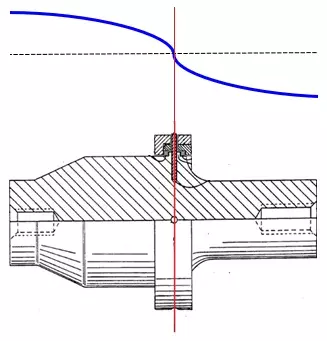FAQ: Would you have any document about adjusting nodal line on ultrasonic boosters? It would be crucial for me to understand this point and find problems regarding booster overheating. Mr. C.Y.

If the nodal line is out of position, the booster Qm and efficiency will decrease when clamped.
The booster is one of the two support regions of the acoustic stack and its core should vibrate freely without its mount O-ring’s interference. Otherwise, it will cause losses and heating. Like the converter, the booster has a nodal line that should coincide with the O-ring flange, as shown above. In the image, the booster nodal line is illustrated in red, coinciding with the support ring (drawing adapted from US patent 4,647,336).
The nodal line is the region where the amplitude of vibration is zero; making an automotive analogy, the nodal point is the center of the wheel. Just as you cannot connect an axle to a wheel off-center, you cannot hold a booster outside the nodal line.
To manufacture boosters, it is essential to maintain the same dimensions, profile and holes depths. Any small change affects the position of the nodal line.
The nodal line is the central acoustic region of the booster, but it does not always coincide with half the length. To ensure the O'ring flange and the nodal line are coinciding, I suggest you to manufacture 05 boosters varying the O'ring flange position (all other dimensions should be exactly the same). These variations may be -1.0 mm, -0.5 mm, nominal, +0.5 mm +1.0 mm. To judge which one works best, just measure the quality factor of the booster with and without the mounting ring; the lower the Qm variation, the best the booster.
Learn more about testing converters and acoustic stacks.
